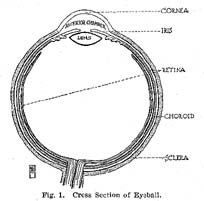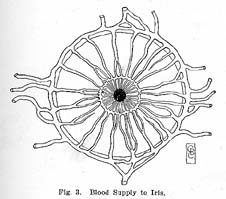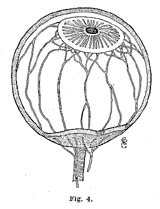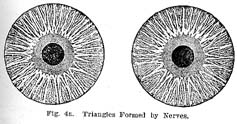
HOME HYGIENE LIBRARY CATALOG TABLE OF CONTENTS GO TO NEXT CHAPTER
Since this volume is intended for the use of the layman as well as of the practicing physician, I shall endeavor to make the anatomical description as brief and simple as possible. To go into detail would only serve to confuse the layman and would not be of any special advantage to the trained scientist.

The eyeball is a hollow, elastic body, about one inch in diameter and nearly spherical in form. The segment of a smaller sphere projects in the front. The larger sphere is made up of three coats--the sclera, choroid and retina.
1. The sclera or sclerotic coat is a tough, opaque fibrous membrane which surrounds about five-sixths of the eyeball. It serves to protect the inner parts from injury and to preserve the spherical shape of the eye.
The cornea is a continuation of the sclera and covers the frontal part of the eye which encloses the anterior chamber containing the aqueous humor. The cornea is as transparent as glass, so as to admit the light unhindered into the interior of the eye.
2. The choroid, or middle coat, is made up of connective tissue, blood vessels and pigment cells. The purpose of the choroid layer and the ciliary body is to supply nutriment to the whole eyeball.
The iris is a forward continuation of the choroid coat. It is a circular, mobile, colored curtain, suspended in the aqueous humor behind the cornea and in front of the crystalline lens. It is perforated a little toward the nasal side of its center by a circular aperture called the pupil. The iris receives its name (iris, irides,--a rainbow) from its varying color effects.
3. An inner coat, called the retina, which is an extension of the optic nerve, serves to receive impressions from the outside world and conveys them through the optic nerve to the center of vision in the occipital lobe of the cerebrum.
A. Surface endothelium. This is a single layer of flat endothelial cells continuous with the posterior lining of the cornea.
B. Stroma, a closely packed mesh-work of delicate radiating connective tissue fibres, enmeshing numerous nerve filaments, blood vessels, lymph vessels and large, irregularly branched connective tissue cells.

C. In the deeper layers of the stroma a band of involuntary muscle fibres, about 1 mm. in width, encircles the pupilary margin of the iris. Reflex contraction of this sphincter diminishes the size of the pupil.
Some authorities describe also radiating muscle fibres stretching from the border of the sphincter to the circumference of the iris. In all probability, however, these are elastic and not muscle fibres, the dilation of the pupil being accounted for by the relaxation of the sphincter muscle and the resulting automatic contraction of the elastic muscle fibres. The brighter the light, the more contracted the pupil, and vice versa. This mechanism aims to regulate the amount of light to be admitted to the retina.
D. Basement membrane consisting of strong connective tissue, which forms the support and innermost layer of the iris.
E. The pigment layer consists of two rows of epithelial cells of a dark purple color, which rest on the uneven surface of the basement membrane of the iris. This pigment layer serves to prevent the penetration of light through the iris into the inner dark chamber of the eyeball.
As described in Chapter IV, there are only two normal iris colors,--light azure blue and light hazel brown.
I. The stroma of the blue iris is devoid of pigment, thus allowing the purple pigment layer to shimmer through as a uniform, clear sky blue.
II. In the normal brown iris the connective tissue cells of the stroma contain a brown pigment which totally obscures the purple pigment layer, thus imparting a uniform, clear light brown color to the iris.
The albino iris contains no pigment either in the connective tissue cells of the stroma or in the pigment layer. The resulting transparency renders the blood vessels visible, hence the iris presents a delicate pink appearance.
For the sake of avoiding confusion we will henceforth consider only the Indo-Caucasian iris which is normally of a uniform brilliant azure color.
The long and short ciliary blood vessels form a complete ring around the peripheral border of the iris.

From this major circle branches are given off which converge toward the pupil.
At a short distance from the outer border of the sphincter muscle they divide and anastomose to form a second ring.
From this minor circle branches continue their course to the pupilary border.
The nerve supply of the iris deserves special attention. The circular muscle fibres are supplied by the short ciliary nerve branch of the motor oculi, or third cranial nerve, coming directly from the brain.

The other structures are supplied by the long ciliary nerve, which is in direct communication with the cervical ganglia of the sympathetic nervous system. These nerves travel forward to the iris through the choroid coat of the eyeball. Along the attached margin of the iris they form a plexus from which nerve filaments are given off to the muscle fibres and other structures of the iris. Some of these nerve filaments also go to form a complete network on the surface of the iris immediately underneath the surface endothelium. These are arranged in triangles, the bases of which rest on the outer rim of the iris, and whose apices point toward the pupil. (Fig. 4a) The sides of these triangles coincide with the blood vessels, these with the sympathetic nerve supply, and these in turn with the borders of the organ areas.

The direct connection of the nerve filaments in the surface layers of the iris with the cervical ganglia of the sympathetic nervous system explains how impressions (vasomotor changes) from all over the body may be conveyed to the iris.
HOME HYGIENE LIBRARY CATALOG TABLE OF CONTENTS GO TO NEXT CHAPTER